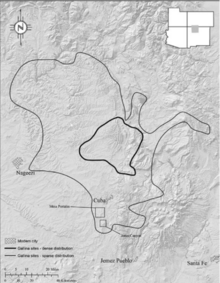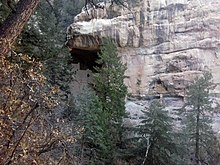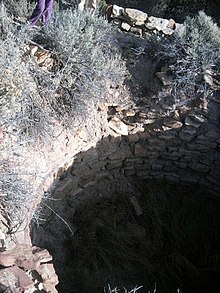154:. The house interiors are seen to have two hearths with banquets, or benches which skirt the walls, these are believed to be used as beds as well as seats. Pit houses often include wing walled storage units. Unit houses often had storage bins that extended off the east and west side of the house. Evidence supports the idea that these bins were used primarily for food/grain storage as remains are often found within. These houses were generally "unit-type" which have thick walls of unworked stones in mud mortar. The interiors of these houses were smooth and neatly plastered. They also contained fire pits with U-shaped deflectors that directed heat and caught ash. There was generally a ventilator shaft through the wall that followed the north-south orientation of the house. The interior roofs were left as beams and bags were hung from them as a storage method. The surface houses were always rectangular, however, the pit houses could be round or rectangular. Both styles of houses were accessed through roof entry, this is evident from the structural remains of ladders.
171:
59:
135:
24:
227:
in order to hunt and gather. Each of these mountain camps had two to ten people and brought a cook pot, water jar, food bowl, and canteen with them, opting not actually to make pottery in the camps. The camps were thought to be more hunting-oriented based on the arrows, knives, and scrapers found at
166:
towers along ridges. The towers generally had thick walls and better than usual masonry. This thickness was probably designed to support the weight. The towers were about 20-30 Ft one story buildings entered on the high level by a ladder. These towers were possibly signal stations similar to a line
121:
Some of the ceramic reusable bowls and jars share similarities with Rosa era pieces, yet there are key differences. For instance, the wide mouth cook pots found commonly at
Gallina sites are not seen among Rosa artifacts. Also, all jars found at Rosa sites have flat bottoms whereas the Gallina jars
245:
In the 1300s the region was slowly depopulated. Contemporary archaeologists suggests a social movement as a potential cause. Most
Gallina sites discovered are found to have been left in perfect order and followed a ritualistic pattern. The fire pits were filled to the rim and then the floors were
98:
from the
Gallina time period are found commonly throughout the region, artifacts include vessels, and lithic tool remains such as projectile points/remnants, evidence of lithic reduction from cores and cobble, hand grinding tools such as the mono and corresponding mattata, and the prominent tri
361:
Borck, Lewis(2018). “Sophisticated Rebels: Meaning Maps and
Settlement Structure as Evidence for Social Movement in the Gallina Region of North American Southwest” In Life Beyond Boundaries: Constructing Identity in Edge Regions of the North American Southwest Boulder: University Press of
232:
because of the retention and radiation of the sun’s heat off the rock. The warmth may have allowed small plots for farming, although this is still under debate. The dwellings and drying areas had paths leading to them that were sometimes "paved" with slabs of rock or filled in with
246:
cleaned. The house was given a quick burning and then the roof timbers were removed. Some archaeologists who follow the belief of abandonment tend to think that this was a process designed to minimize the abilities of someone to use personal artifacts left behind in
250:. While forensic evidence of violence and exist within the region, there is no certainty in regards to the cause. Hypotheses of the past have included explanations from genocide to internecine war. Although there is no hard evidence for either, research is ongoing.
99:
notched axe head. There are indications that the
Gallina were advanced at basket weaving. Most flakestone found on Gallina sites is made from quartzite, obsidian, and chert. The lithic materials can be traced to local stone deposits such as
210:
conditions. Although not every year was bad, the pattern was increasingly dry. From 1250 to 1265 the drought was particularly bad, and the years 1278 and 1292 were the worst. All of the dates for droughts and predicted impact on crops are
126:. The Gallina also modified the necks of their jars, more than likely designed to allow the jar to be easier to hold. The Gallina are recognized for their black on white, grey utility, corrugated and basket impressed pottery designs.
87:, black on white pottery, and architecture. They also have similar ornaments such as shells pierced for stringing, bone beads, and stone pipes. More recent scholarship has suggested the Gallina phase emerged through a social movement.
335:
Ford, R.I., A.Schroeder, and S.L. Peckham 1972 Three
Perspectives on Puebloan Prehistory. In New Perspectives on the Pueblos, edited by A. Ortiz, School of American Research. University of New Mexico Press,
142:
Gallina architecture was also influenced by the Rosa style. Villages ranged from three to twenty dwellings and were generally combinations of surface structures and
380:
375:
342:
122:
commonly have a tapering underbody that end in a point. This was probably designed to allow the jar to be settled upright in a bed of ashes in the
40:
339:
Ellis, Florence. “Canjilon
Mountain Hunting and Gathering Sites.” From Drought to Drought: Gallina Cultural Patterns Volume 1. 1988.
167:
of telegraph stations. While the possibility of reuse for food storage is plausible, the fact remains that was not the intended use.
194:
that were contemporaneous with the
Gallina, have not been discovered in the Gallina area. A few possible examples were noted by
390:
385:
170:
352:
Stuart, David. Glimpses of the
Ancient Southwest. Santa Fe, New Mexico: Ancient City Press. 1984. (Only pages 86–92)
237:
stones. Ellis believed these sites to be associated with the
Gallina; many other archaeologists, however, do not.
191:
17:
95:
195:
58:
43:
in the American Southwest from approximately 1050 to 1300. The culture was located in north-central
76:
223:
At some point during difficult drought conditions, some members traveled from villages to camp on
281:
Borck, Lewis; Bremer, J. Michael (Winter 2015). "Ordinary, yet Distinct: the allure of Gallina".
80:
52:
72:
134:
224:
212:
100:
48:
319:
Guide to Ceramic Indetification: Northern Rio Grande Valley and Galisteo Basin to AD 1700
303:
107:
84:
369:
146:
with north-south orientation. The pit houses were often dug in the high points of
23:
247:
44:
143:
234:
229:
151:
123:
103:
207:
163:
183:
169:
133:
110:
57:
22:
321:(2nd ed.). Santa Fe, New Mexico: Laboratory of Anthropology.
187:
174:
A reconstructed tower of the Gallina culture Northern New Mexico
147:
343:
Ancient Massacre Discovered in New Mexico -- Was It Genocide?
206:
Starting in 1161, the ecological condition shifted toward
228:
the sites. The camps were most frequently located on
62:
Nogales (Spring) Cliff Houses in Northern New Mexico
55:(and Largo Canyon), which runs through the region.
355:Historical Dictionary of North American Archeology
39:culture was an occupation sequence during the pre-
8:
71:The Gallina are tentatively linked to the
79:. Evidence indicates a connection to the
259:
198:, but their identification is tenuous.
190:, the standard material indications of
298:
296:
381:Native American history of New Mexico
7:
376:Native American tribes in New Mexico
276:
274:
272:
358:Handbook of North American Indians
14:
83:, due to similar skills such as
1:
241:Abandonment and/or migration
219:Camps and mountain dwellings
192:Ancestral Puebloan religions
407:
317:Wilson, Gordon P. (2007).
138:Pit and Unit house layout
51:, and was named after the
15:
347:National Geographic News
304:"Ordinary, yet Distinct"
162:The Gallina constructed
18:Gallina (disambiguation)
345:, by Blake de Pastino,
213:based on conifer growth
391:Pre-Columbian cultures
175:
139:
63:
28:
386:Oasisamerica cultures
283:Archaeology Southwest
196:Florence Hawley Ellis
173:
137:
61:
47:roughly north of the
26:
150:and then completely
16:For other uses, see
215:(from tree rings).
91:Tools and artifacts
77:Ancestral Puebloans
176:
140:
64:
29:
27:Region of Gallina
225:Canjilon Mountain
398:
349:, July 12, 2007.
323:
322:
314:
308:
307:
300:
291:
290:
278:
267:
266:Ford et al. 1972
264:
406:
405:
401:
400:
399:
397:
396:
395:
366:
365:
332:
327:
326:
316:
315:
311:
302:
301:
294:
280:
279:
270:
265:
261:
256:
243:
221:
204:
181:
160:
132:
119:
93:
69:
49:Jemez Mountains
41:Hispanic period
21:
12:
11:
5:
404:
402:
394:
393:
388:
383:
378:
368:
367:
364:
363:
359:
356:
353:
350:
340:
337:
331:
328:
325:
324:
309:
292:
268:
258:
257:
255:
252:
242:
239:
220:
217:
203:
200:
180:
177:
159:
156:
131:
128:
118:
115:
101:Jemez Mountain
92:
89:
85:basket weaving
68:
65:
13:
10:
9:
6:
4:
3:
2:
403:
392:
389:
387:
384:
382:
379:
377:
374:
373:
371:
360:
357:
354:
351:
348:
344:
341:
338:
334:
333:
329:
320:
313:
310:
305:
299:
297:
293:
288:
284:
277:
275:
273:
269:
263:
260:
253:
251:
249:
240:
238:
236:
231:
226:
218:
216:
214:
209:
201:
199:
197:
193:
189:
185:
178:
172:
168:
165:
157:
155:
153:
149:
145:
136:
129:
127:
125:
116:
114:
112:
109:
105:
102:
97:
90:
88:
86:
82:
78:
74:
66:
60:
56:
54:
50:
46:
42:
38:
37:Largo-Gallina
34:
25:
19:
346:
336:Albuquerque.
330:Bibliography
318:
312:
286:
282:
262:
244:
222:
205:
182:
161:
141:
130:Architecture
120:
94:
70:
36:
32:
30:
81:Rosa people
53:Rio Gallina
370:Categories
254:References
248:witchcraft
144:pit houses
73:Rosa Phase
45:New Mexico
362:Colorado.
230:lava beds
152:palisaded
96:Artifacts
235:chinking
179:Religion
124:fire pit
108:Pedernal
104:Obsidian
67:Ancestry
208:drought
202:Drought
184:Sipapus
164:masonry
117:Pottery
75:of the
33:Gallina
158:Towers
188:kivas
148:mesas
111:Chert
289:(1).
186:and
113:.
106:and
31:The
35:or
372::
295:^
287:29
285:.
271:^
306:.
20:.
Text is available under the Creative Commons Attribution-ShareAlike License. Additional terms may apply.



